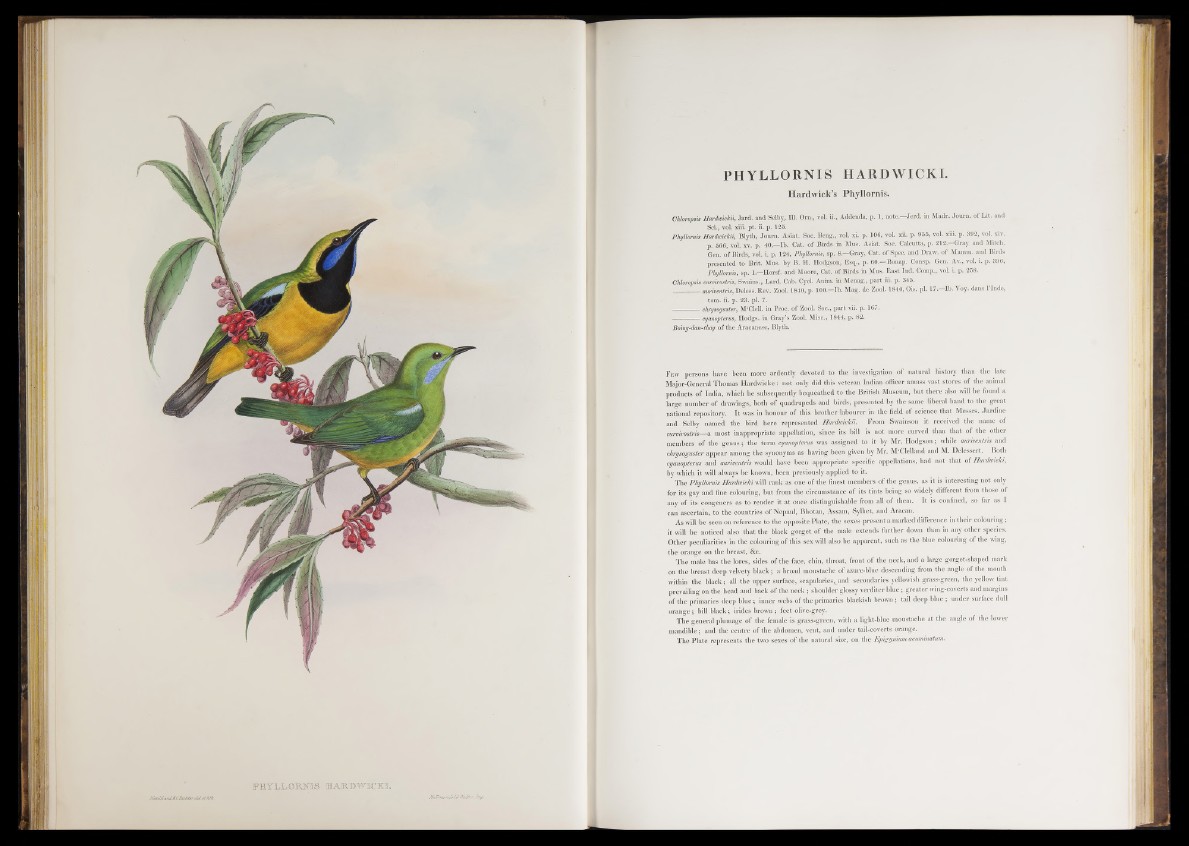
JGouldanJ.KC.im U r riel d 7M .
PHYLLORNIS IARDWICII.
J fu ffm sn d rU Wafrnr, fr y .
Hardwick’s Phyllornis.
Chloropsis Hardmickii, Jard. and Selby, 111. O m , vol. i i . Addenda, p. 1, n o te—Jerd. in Madr. Joum. of Lit. and
Sci., vol. xiii. pt. ii. p. 125.
Phyllornis Bardmckii, Blyth, Joum. Asiat. Soc. B en g , vol. ri. p. 106, vol. xii. p. 956, vol. xiii. p. 392, vol. xiv.
p. 566, vol. xv. p. 4 0—lb. Cat. of Birds in Mus. Asiat. Soc. Calcutta, p. 2 1 2— Gray and Mitch.
Gen. o f Birds, vol. i. p. 124, Phyllornis, sp. S.—Gray, Gat. of Spec, and Draw, o f Mamm. and Birds
presented to Brit. Mus. by B. H. Hodgson, E sq , p. 6 0— Bonap. Consp. Gen. Av„ vol. i. p. 396,
Phyllornis, sp. 1,—Horsf. and-Moore, Cat. of Birds in Mus. East Ind. Comp, vol. i. p. 258.
Chloropsis curvirostris, Swains, Lard. Cab, Cyci. Anim. in Menag, part iii. p. 345.
________ auriventris, Deless. Rev. Zool. 1840, p 1 0 0 —lb Mag. de Zool. 1840, Ois. pi. 1 7—lb. Voy. dans l ’Inde,
tom. ii. p. 23. pi. 7.
•-------------chrysog aster, M'Clell. in Proc. of Zool. Soc., part vii. p. 167.
------------- cyanopterus, Hodgs. in Gray’s Zool. Misc., 1844, p. 82.
Boing-dan-thay o f the Aracanese, Blyth.
F ew persons have beeu more ardently devoted to the investigation of natural history than the late
Major-General Thomas Hardwicke: not only did this veteran Indian officer amass vast stores of the animal
products of India, which he subsequently bequeathed to the British Museum, but there also will be found a
large number of drawings, both o f quadrupeds and birds, presented by the same liberal hand to the great
national repository. I t was in honour of this brother labourer in the field of science that Messrs. Jardine
and Selby named the bird here represented Hardwickii. From Swainson it received the name of
curvirostris—a most inappropriate appellation, since its bill is not more curved than that of the other
members of the g en u s; the term cyanopterus was assigned to it by Mr. Hodgson; while auriventris and
chrysogaster appear among the synonyms as having been given by Mr. M'Clelland and M. Delessert. Both
cyanopterus and auriventris would have been appropriate specific appellations, had not that of Hardtoicki,
by which it will always be known, been previously applied to it.
The Phyllornis Hardtoicki will rank as one of the finest members of the genus, as it is interesting not only
for its gay and fine colouring, but from the circumstance of its tints being so widely different from those of
any of its congeners as to render it at once distinguishable from all of them. It is confined, so far as I
can ascertain, to the countries of Nepaul, Bhotan, Assam, Sylhet, and Aracan.
As will be seen on reference to the opposite Plate, the sexes present a marked difference in their colouring;
it will be noticed also that the black gorget, of the male extends further down than in any other species.
Other peculiarities in the colouring of this sex will also be apparent, such as the blue colouring of the wing,
the orange on the breast, &c.
The male has the lores, sides of the face, chin, throat, front of the neck, and a large gorget-shaped mark
on the breast deep velvety black; a broad moustache of azure-blue descending from the angle of the mouth
within the black; all the upper surface, scapulariesv and secondaries yellowish grass-green, the yellow tint
prevailing on the head and back o f the n e ck ; shoulder glossy verditer b lue; greater wing-coverts and margins
of the primaries deep blue; inner webs of the primaries blackish brown; tail deep blue ; under surface dull
o ran g e; bill black; irides brown; feet olive-grey.
The general plumage of the female is grass-green, with a light-blue moustache a t the angle of the lower
mandible; and the centre of the abdomen, vent, and under tail-coverts orange.
The Plate represents the two sexes of the natural size, on the Epigynium acuminatum.